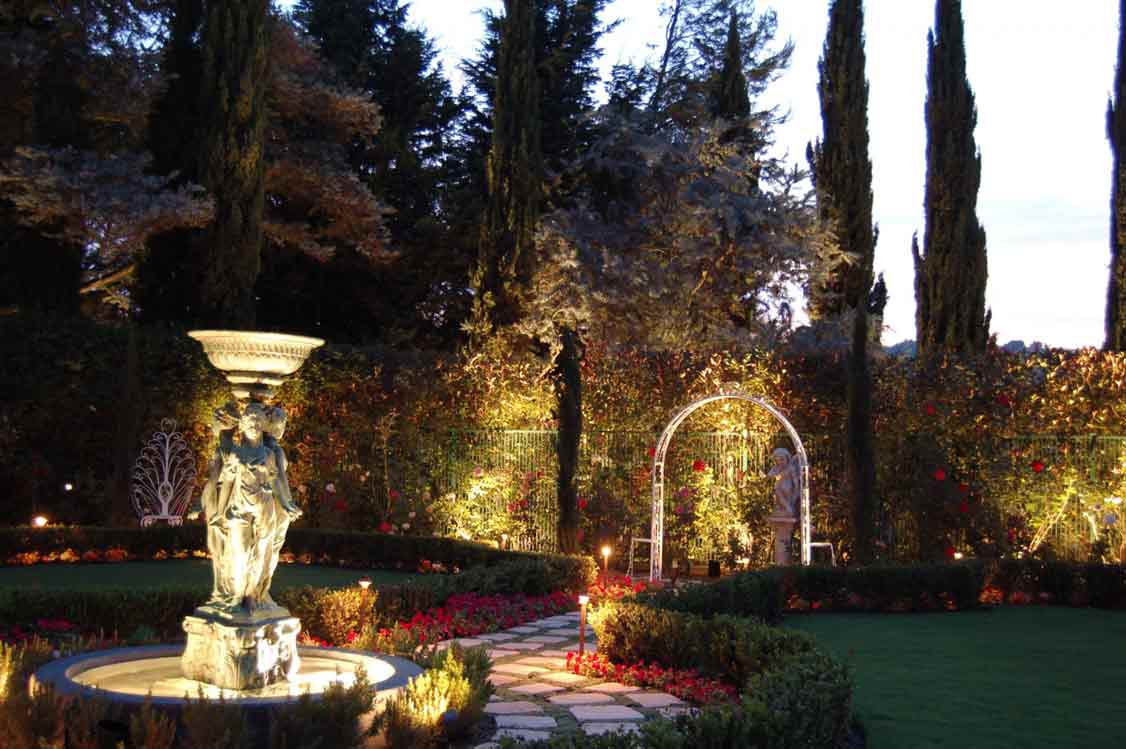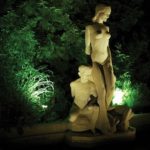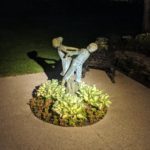Many landscapes boast statues and other specialty items. A statuary could be as modest as a garden gnome, bird bath, or sundial. They require attention brought to them after sunset through sculpture lighting. The lighting should not only illuminate the sculpture but also make it as good-looking at night as it is during daytime.
In the following sections, we look at how best to light sculptures to bring out the best in them.
How to: Sculpture lighting
Statues are a reflection of our aesthetics and pride. They bring magnificence to our outdoor spaces. To capture their essence after dark, it’s crucial to illuminate key features that convey expression, emotion, movement, and craftsmanship. Show off the shape, form, color, and texture of the artistry.
This is true whether you are portraying a human figure, an animal carving, or an intricate Japanese design,
- For sculptures depicting human figures, highlight facial features to convey emotion and express movement if that is the statue’s intention. For example, a left-facing woman can be emphasized with right-sided lighting, with extra lighting to highlight movement. Illuminate faces with subtlety for a shy look and boldly, with possible deep shadows, for strong masculine figures.
- When dealing with animal sculptures, draw attention to fur details to accentuate their lifelike qualities and movement.
- To emphasize a specific element in a sculpture, direct a narrow beam of light onto that particular feature to highlight it.

In this image, the sculpture is front-lit from about 3 feet with a medium beam spread lamp to the right. This washes and emphasizes the right side of the subject with light. Washing the shrubs with light acts as a lit backdrop. Much theatrical!
What to Consider
Consider the sculpture’s size, physical attributes, and any distinctive features. Aim to emphasize these aspects for the viewer’s interpretation.
If the statuary boasts an intriguing texture, use a grazing technique to reveal intricate details. Use a washing technique when the main features are either pattern or color or when texture is not a key feature.
Think of how the sculpture fits into the overall composition and how this will influence the lighting.
- Typically, sculptures are seen as the primary focal point and are illuminated with the brightest light level to emphasize their presence. The brightness of other elements is then lowered to fit their roles in the composition.
- For sculptures playing a minor role, a softer brightness level is more applicable.
- A classical warrior positioned in front of a hedge can be likened to an actor on stage. Subtle lighting behind or on the sides of the stature can wash the hedge, providing a suitable theatrical backdrop and preventing uneven shadows on the hedge.
- A running figure or an animal sculpture may be portrayed emerging from the dark by not lighting the backdrop for peak movement and drama.
- A statue tucked away in a corner should be showcased as a hidden element of the landscape. Use less brilliant lamps or lower the lumen output for features like this.
Fixture placement:
Lamp placement is not only influenced by the sculpture itself but also by its surroundings.
- Position luminaries at a convenient distance to the front to highlight facial expressions. One wash fixture to the side casts light across the sculpture to accentuate texture while adding some 3-dimensionality.
- Accent lights at the front and back emphasize form and detail while fill-in lights on the remaining sides soften details adding dimensionality to the subject.
- A centrally positioned fixture with a flood distribution lamp, depending on the distance, can wash the entire sculpture, showcasing detail without texture.
- For sculptures with obscured features, such as a figure with arms akimbo, placing the luminaire back from the base allows light to illuminate the face, neck, and shoulders.
- While bulky plinths may obstruct optimal lighting for the sculpture/bust, recessed uplights can be integrated into large plinths. Ensure to cast some light onto the plinth itself. This is to prevent the statue from appearing airborne in the dark; unless it is intended to create an illusion of a flying bird. Statues on dark plinths will stand out effectively.
Experiment with a handheld torch at night to determine optimal positions.
Aiming angle:
The aiming angle is determined by fixture location.
- An angle significantly less than 30° from the vertical plane results in fixtures being close to the sculpture exaggerates textures due to extreme shadowing.
- The ideal angle of incidence for lighting sculptures is considered to be 30°, known as the “museum angle.” It ensures even illumination on horizontal and vertical surfaces
- An angle significantly greater than 30° may result in a flat appearance.
In lighting design, the angle of incidence is the measurement taken between the angle at which a light source strikes a surface and the 90-degree vector perpendicular to that surface, known as the surface normal.
Light intensity:
Statues, often serve as focal points, demanding bright lighting.
When multiple focal points compete for attention, they don’t need equal illumination. Secondary focal points should be less intense. If the statue is the primary focus, make it the brightest to establish its dominance.
The brightness will also depend on the surface reflectance, which is influenced by color and texture.
Statues made of materials like polished marble or porcelain can attract attention to a great effect even with subdued lighting. This is thanks to their shiny, reflective surfaces. Bright surfaces such as white marble require lower intensity. Meanwhile, dark bronze statues need brighter lighting to stand out.
Viewpoints
For a single viewing direction;
- Focus the lighting on the visible surface. The back of the sculpture, often unseen from this perspective, does not require illumination. However, soft side illumination brings out the form and 3-dimensionality of the subject.
- When the sculpture is positioned against a wall or surrounded by shrubbery, soft lighting for the background surface can enhance depth and serve as a backdrop for the artwork.
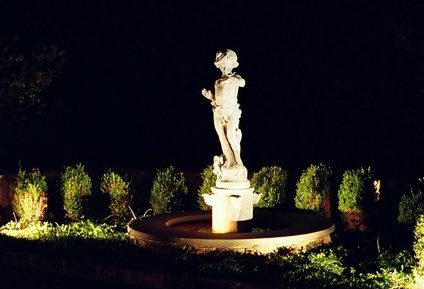
Statue lighting for a single viewpoint
For sculptures visible from multiple directions:
- All-round illumination should address the various angles.
- Instead of distributing light evenly, you may opt to create distinct appearances from different viewpoints.
- Utilizing two accent fixtures positioned closely on opposite sides can emphasize shape or outline. Additional lower-wattage, wide-angle fixtures placed farther away can softly wash the overall shape.
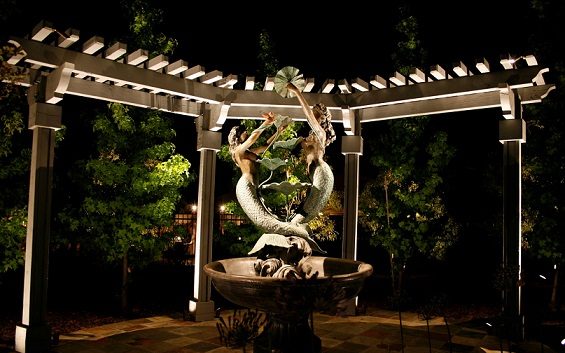
Lighting for multiple viewing angles
Consider the view from inside the house, too. A statue observed from a distance must be illuminated more brightly than one situated near a window or patio.
Lighting Techniques
Sculpture lighting techniques are as diverse as the sculptures themselves.
- Uplighting: For statues with softer lines, uplighting is ideal, casting captivating shadows and producing a dramatic effect. The proximity of the light source determines the concentration and focus of the illumination. A fixture close to the sculpture brings out the texture while one farther away softens the details. Avoid uplighting for upward-facing figures.
- Cross Lighting: Illuminating a statue from one side can result in an uneven appearance. Crosslighting, from two opposing directions ensures comprehensive and balanced illumination.
- Downlighting: Ideal for upward-facing statues, those on large plants, or plant containers. Downlighting mimics daylight, creating shadows that transform textural details and facial expressions. Many features may benefit from uplighting, downlighting, and crosslighting.
- Shadowing: When a statue is against a wall or hedge, front lighting can create captivating shadows on the surface behind it.
- Backlighting and Silhouetting: Silhouetting emphasizes the form and shape of the sculpture by lighting a wall behind it, creating a silhouette effect. Backlighting, on the other hand, involves illuminating statues from behind, producing a halo effect on the sides. While silhouetting requires a surface behind the sculpture, backlighting doesn’t.
Fixture selection
Opt for low-voltage LED fixtures (9 to 24 V) for safety and ease of handling. A transformer is necessary to step down the voltage from the standard ~240 Volts to a safe ~12 Volts.
Color temperature options range from warm orange to cool blue-white and color-changing alternatives. Match the color temperature to the color of the sculpture. For instance, a limestone stone or dark bronze sculpture is best lit using a warm-white lamp. A bluer subject is best lit by a blue-white lamp.
When selecting outdoor lighting solutions, prioritize fixtures designed to withstand outdoor elements like rain, snow, wind, and extreme temperatures. Choose lights specifically UL-listed for damp/wet locations to ensure protection against water damage and optimal performance in outdoor environments.
To Wrap Up
Ultimately, your choice of lighting fixtures should align with your artistic vision, considering the statue’s characteristics and the desired ambiance in your outdoor space. specialty items are usually very personal to the owner and should be treated as such using up lights to Accent a statue.
If you are fortunate to own a sculpture, consult the artist about appropriate lighting, as he/she may have strong feelings on the subject.
That’s it for now!

